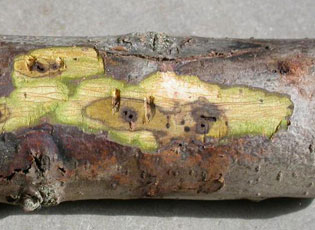Introduction
Thousand cankers disease (Geosmithia morbida) is a disease complex that affects walnut trees. The complex begins with the infestation of vulnerable walnut trees by the walnut twig beetle, Pityophthorus juglandis. During its adult stage, Pityophthorus juglandis makes contact with the fungal pathogen, Geosmithia morbida. The adults subsequently bore into the bark of infested trees to overwinter or lay eggs. As the beetles tunnel into the host, they unwittingly introduce the fungus, which germinates in the woody tissue. Once the fungus has become established, it induces the formation of cankers on the diseased branches. Large beetle populations can overwhelm infested trees, causing them to decline rapidly. Infected trees may experience tree mortality within 2 to 3 years of the initial infestation.
Thousand cankers disease is native to the western United States. The effects of the disease were first described by researchers in the late 1990s and early 2000s. During this period, walnut trees in the Western and Central United States were perishing at an alarming rate. The rash of tree mortality was initially attributed to a drought that extended over several years. Further analysis of the infected trees resulted in the detection of the relationship between Pityophthorus juglandis and Geosmithia morbida.
Distribution & Habitat
Thousand cankers disease occurs across much of the United States. Infection sites have been reported in Arkansas, Delaware, Georgia, Illinois, Indiana, Iowa, Kansas, Kentucky, Maryland, Michigan, Minnesota, Missouri, New Jersey, New York, North Carolina, Ohio, Pennsylvania, South Carolina, Tennessee, Virginia, West Virginia, and Wisconsin.
Hosts
Thousand cankers disease infects walnut trees. Black walnut is the most common host.
Disease Cycle
The adult beetles are vectors for the infectious spores produced by the fungal pathogen. The pathogen grows around the pupal chambers of the beetles. Soon after the beetles emerge from their pupal chambers, they tunnel into the branches and trunk of their hosts, where they reside to overwinter or lay eggs. During this period, the fungus is introduced into the tree. The fungus initially colonizes the tissue surrounding the tunnels. Over the next few weeks, black, oval-shaped cankers develop, and begin to expand beyond the chambers. The cankers can reach up to 3 cm in diameter. The cankers are induced each time a beetle tunnels into the host. Dense beetle populations can cause a multitude of cankers to form. The cankers decay the phloem, which disrupts the host’s vascular system. As the disease advances, the cankers coalesce, girdling the infected twigs and branches. Diseased plants often become infested by more bark beetles, which results in the formation of additional cankers. Eventually, the beetle attacks and ploriferation of cankers overwhelms the tree, causing it to expire.
Symptoms of Infection
Unlike other canker diseases, when a tree is infected by thousand cankers disease, the bark does not slough off. Instead, it remains firmly attached to the trunk, preventing the necrotic areas from being easily discerned. If the outer bark is stripped away, the beetle tunnels and branch cankers will often be apparent. Infected parts of the tree may become shallow or sunken. Severely infected trees may exude sap from the beetle tunnels. The sap will often trickle down the trunk, causing a dark amber stain to form on the bark surface.
External symptoms become more visible as the host declines. Once the disease has advanced into the trunk, more branches are girdled. This results in a discoloration of the tree’s crown, which can be widespread, or relegated to individual branches. The leaves of infected trees will often abruptly wilt. The upper portion of the crown will gradually die back. Host trees typically succumb to infection within 2 to 3 years.
Management
- When planting, select varieties of walnut that exhibit an increased resistance to thousand cankers disease. Arizona, California, and little walnut are some of the most resistant varieties.
- The wood from infected trees may be used for commercial purposes, but the bark, phloem, and cambium should be removed first, to reduce the spread of the disease.
- After they have been harvested, walnut trees intended for shipment to garden centers, households, or nurseries should be inspected for the beetle galleries, cankers, or dieback.
- There is currently no chemical treatment available for control of thousand cankers disease.
- Infected trees can be culled to prevent the disease from spreading to healthy trees.
- Areas where infections have been detected can be placed under quarantine to manage the disease.
Photo courtesy of Ned Tisserat, Colorado State University, Invasive.org


